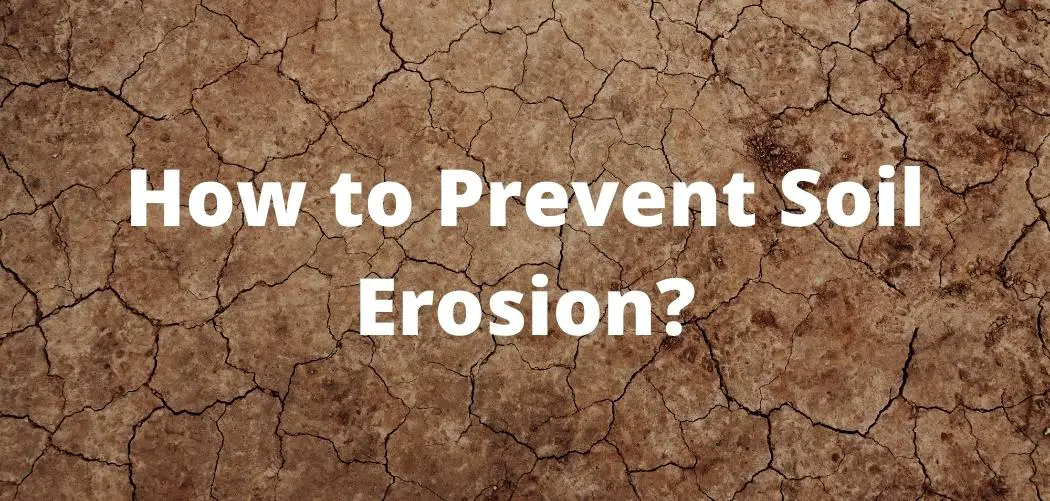We're an affiliate
We hope you love the products we recommend! Just so you know, we may collect a share of sales or other compensation from the links on this page. Thank you if you use our links, we really appreciate it!

How to Prevent Soil Erosion? Soil erosion can be a huge issue for farmers and gardeners. It can lead to decreased yields and loss of topsoil. In this blog post, we will discuss what soil erosion is, how it happens, and some methods that can be used to prevent it. Soil erosion can have devastating effects on our environment and our economy. It is important to understand the causes of soil erosion and take steps to prevent it from happening.
Table of Contents
What is soil erosion and what are the causes of it?
Soil erosion is the process by which soil is removed from one location and transported to another. This can happen through wind or water. Soil erosion can cause several problems, including decreased crop yields, loss of topsoil, and increased flooding. It can also lead to sedimentation in waterways, which can damage ecosystems and clog up infrastructure.
7 Strategies on How to Prevent Soil Erosion
Soil erosion is a serious problem and it is important to take steps to prevent it from happening. There are several methods that can be used to mitigate soil erosion, including:
1. Plant trees and shrubs
To keep the soil in your yard from eroding, you need to plant trees and shrubs. Trees provide shade for plants below them, which helps stop the soil from drying out. Shrubs also help with erosion prevention by providing a barrier of protection between high winds and your lawn. Not only that, but they make great natural fences as well!

The best time of year to plant is in late winter or early spring; this way your new plants will be fully grown before summer when they could become damaged by the hot sun and heavy rainstorms. Plus planting now ensures that you’ll have plenty of blooms come next springtime!
2. Install fences or barriers around your property
Install fences or barriers around the property to Prevent Soil Erosion is not only good for keeping people out of your property, but it also protects plants and animals on your land. When soil erodes, this means that topsoil washes away and damages the ground below it by making it hard for plants to grow in these areas. So if you want to keep your plant life healthy and strong, then make sure you install some fences so that erosion does not happen!
3. Create terraces on your property
Terracing is an age-old way of preventing soil erosion. It’s a technique that has been used for centuries to control water runoff and keep the soil in place. By creating terraces on your property, you can help prevent soil erosion and protect your land from being washed away.
The best way to create terraces is by using a shovel or a hoe. You can either dig trenches or build mounds of soil. The key is to create a series of level surfaces that will slow down the flow of water and keep the soil in place.
4. Compost or use mulch

Compost and mulch can both help to prevent soil erosion. Compost is made up of organic matter, such as leaves, grass clippings, and food waste. Mulch is a layer of material that is spread on the ground to cover the soil. It can be made from organic or inorganic materials. Both compost and mulch help to keep the soil in place and protect it from wind and water erosion. They also help to improve the soil quality.
5. Practice crop rotation
Cropping rotation is a type of agriculture that helps to prevent soil erosion. It does this by rotating the types of plants that are grown in a particular area, which allows the soil to rest and replenish its nutrients. This practice has been used for centuries and is still an important tool in preventing soil degradation today.
Cropping rotation can also help to improve the soil’s overall health, which can lead to increased yields and better-quality crops. By rotating the types of plants that are grown, you can also help to reduce the incidence of pests and diseases. So if you are looking for a way to improve the health of your soil, and protect it from erosion, then consider using a cropping rotation system.
6. Use no-till farming methods
reduce or eliminate soil erosion by using no-till farming methods. This can be done by planting crops that don’t require plowings, such as cover crops and different types of grasses, or by growing perennial plants that grow back each year without being replanted. If you do need to plow the land, make sure only small areas are tilled at a time so they have time to recover before you till them again.
7. Plant cover crops

Soil erosion can be prevented or slowed by planting cover crops. Cover crops are plants that are grown specifically to protect the soil from erosion. They are typically planted in the fall and winter after the main crop has been harvested, and they help to keep the soil in place while it is bare. Cover crops also add organic matter to the soil, which helps to improve its structure and fertility.
If you are concerned about soil erosion on your property, there are several things that you can do to prevent it. By taking some simple steps, you can help protect your soil and keep it healthy for years to come.
is soil erosion good or bad?
Soil erosion is both good and bad. It can be seen as good because it helps to create new soil, but it is also bad because it causes the loss of topsoil, which is necessary for plant growth. Soil erosion can also lead to the formation of gullies and ravines, which can damage property and create hazards for people and wildlife.
what is the good effect of soil erosion?
The good effect of soil erosion is that it provides nutrients to plants in areas with poor soils or infertile ground. For example, wind-blown silt may provide much-needed nutrients to dry sub-deserts where rainfall is minimal.
In some cases, this has led to an increase in the number of plant species present as well as an overall increase in biomass production (the total mass produced by all living things). The increased nutrient supply also means that there is more organic matter in the soil, which helps to improve soil structure and water-holding capacity.
Conclusion
Erosion is a natural process that happens when water, wind, or ice remove soil from one place and deposit it somewhere else. There are several ways to prevent or reduce soil erosion. Each of us can play a role in preventing soil erosion by taking some simple steps and helping prevent soil erosion by following these tips.

